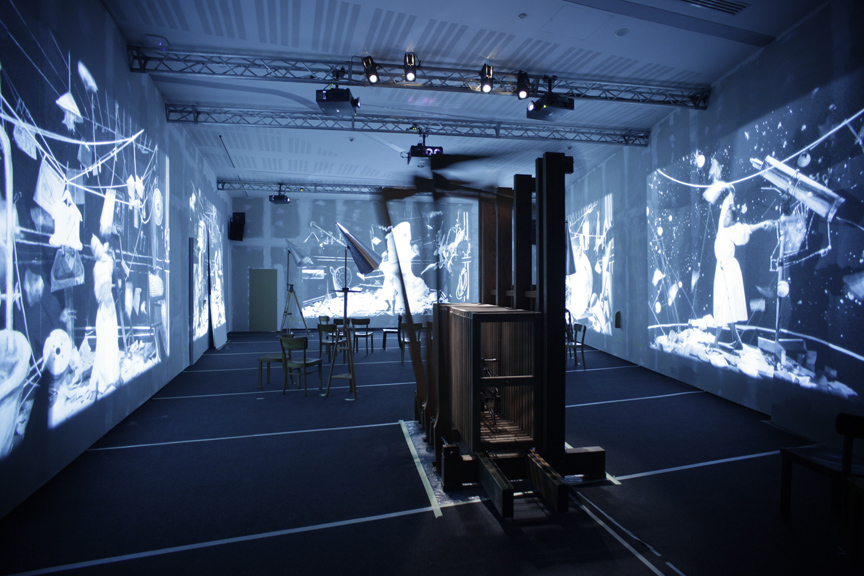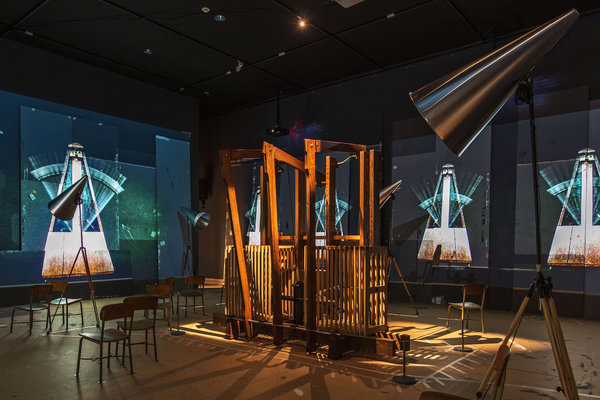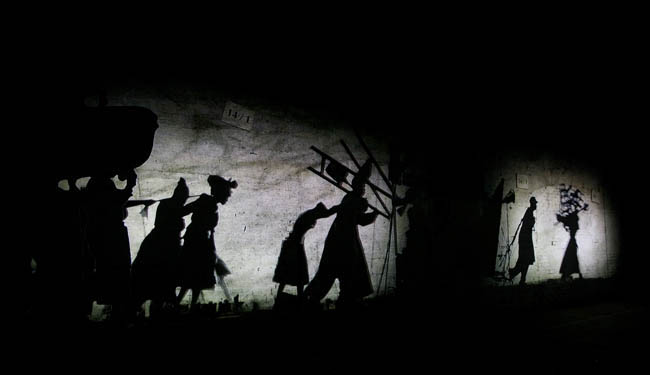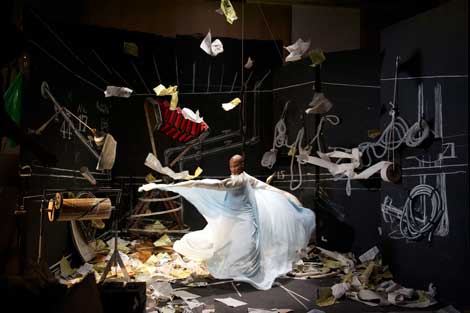William Kentridge’s dazzling “The Refusal of Time,” at New York’s Metropolitan Museum, marries science and art in an installation that comprises a 30-minute, 5-channel video featuring live stop-action animation, the spoken word and music projected on three walls of a distinctly un-Met Museum-like room. The piece is a collaboration between Kentridge and Peter Galison, professor of History of Science at Harvard, and centers on changing conceptions of time from the earliest celestial approach to Newton’s mathematical interpretation and Einstein’s theory of relativity.
According to the accompanying literature: “Galison studied a 1905 paper on relativity in which Albert Einstein hypothesized that, due to the delay in signals relayed via telegraph wire, peripheral railway stations synchronized on a centralized clock were forever fated to operate seconds behind schedule. Einstein’s nascent theories about the relativity of time converged with French mathematician Henri Poincaré’s development, as president of the Bureau des Longitudes, of global time zone maps at the dawn of the 20th century. Both scientists faced the radical idea, in a newly industrialized and interconnected world, that time is not absolute but relative and resistant to control.”
For Kentridge the refusing of time has both specifically human and larger political ramifications. “Everybody knows that we are going to die, but the resistance to that pressure coming towards us is at the heart of the project. At the individual level, it was about resisting; not resisting mortality in the hope of trying to escape it, but trying to escape the pressure that it puts on us.” And, it further refers to “a refusal of the European sense of order imposed by time zones; not only literally, but this refusal also referred metaphorically to other forms of control as well.”
The installation space resembles a rather shabby pre-production theater with notes affixed here and there to the rough cobbled-together, sheet-rock that forms the walls. A bizarre, antique-looking SUV-sized “breathing machine” constructed of wood, its bellows pumping away, is positioned at one end. Called the elephant after an industrial machine in Dickens’ Hard Times that moves “monotonously up and down, like the head of an elephant in a state of melancholy madness,” Kentridge’s behemoth was inspired by the subterranean pneumatic tubes proposed in the 19th century that would use forced air as a means of regulating the clocks of Paris. It’s certainly a relentless beast of a thing whose incessant kinesis is a potent metaphor for time marching on and the futility of trying to govern it.
Kentridge’s extended and quite free form exploration of time employs some images that are straightforward like metronomes, but others such as the musical instruments and the various black South Africans who caper about their “Cabinet of Dr. Caligari” funhouse and mix up bombs in their laboratory, are more enigmatic. I loved the scenes of Kentridge on an endless loop marching around his studio stepping over a tufted chair. Projected concurrently with this, on another wall, he’s seen madly moving a couple of straight back chairs deferentially under the path of a regal looking black South African boy Sir Walter Raleigh-style. The male figure in the white gown dancing amid the flying papers that looked like doves was simply mesmerizing. These curious images are like snatches from dreams or memory and seem not only to convey temporal entropy, but also speak to Kentridge’s recurring themes of colonialism and oppression. And of course there are his drawings—not enough here for my taste. But they’re captivating; done with sand, the marks and lines cavort and spiral across the walls possibly representing stars, trajectories, the Universe and infinity.
You soon realize Kentridge wants “The Refusal of Time” elusive and hard to grasp…kind of like time itself. He ensures this is the case, even orchestrating the placement of the chairs for viewers’ use. They appear arranged haphazardly around the space in a completely casual manner, but if you try and move them, you realize they are bolted to the floor, frustrating your attempts to gain a better view. So you’re left, as Kentridge wants it, with only fragments.
In addition to Galison, Kentridge also collaborated with Catherine Meyburgh and Philip Miller. “The Refusal of Time” is jointly owned by The Metropolitan Museum of Art and the San Francisco Museum of Modern Art.
William Kentridge, “The Refusal of Time” at the Met ends May 11, 2014 ; info metmuseum.org




